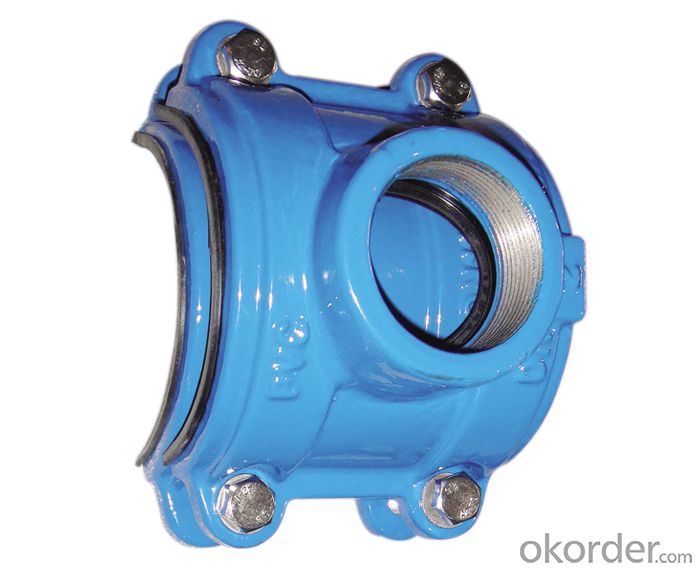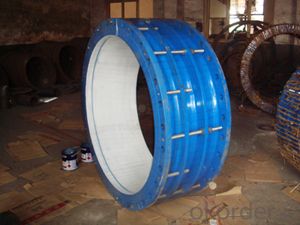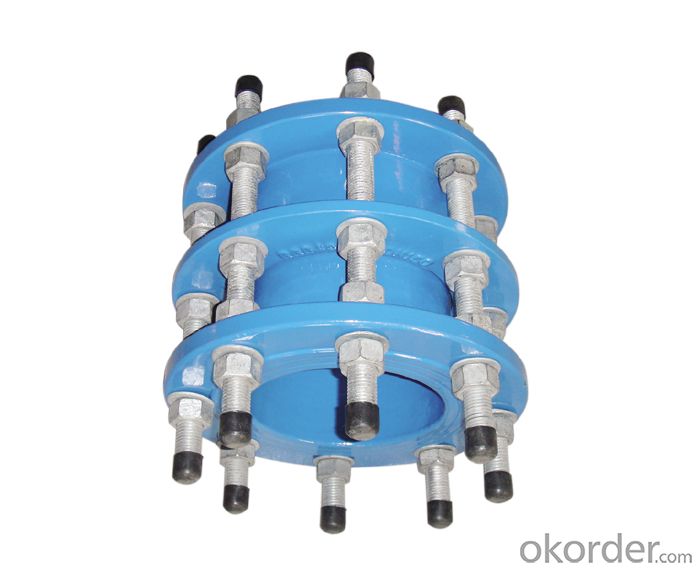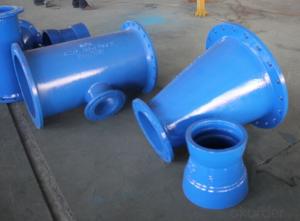DI Pipes in Water project,ductile iron double flanged taper with concentric
- Loading Port:
- Tianjin
- Payment Terms:
- TT OR LC
- Min Order Qty:
- 100 pc
- Supply Capability:
- 10000 pc/month
OKorder Service Pledge
OKorder Financial Service
You Might Also Like
DI Pipes in Water project,ductile iron double flanged taper with concentric
ISO 2531 / EN 545 / EN 598 / GB 13295
Specifications
Flanged Fittings
| Material | |
| Ductile iron grade 500-7 / 450-12 in accordance with ISO 1083 | |
| Flange | |
| P 10, PN16 or PN25 drilling in accordance with ISO 7005-2 / EN 1092-2 | |
| Fluid Temperature | |
| 0°C-50°C, excluding frost | |
| Coating | |
| External coatings | Internal coatings |
| zinc + bitumen painting liquid epoxy resin painting | cement mortar lining liquid epoxy resin painting |
| Reference Rules | |
| Dimensions and testing in accordance with ISO 2531 / EN 545 | |
| Use | |
| Jointed by the bolts, nuts and sealed by the gaskets. | |
China National Building Materials Group Corporation (CNBM) was established in 1984 with approval from the State Council, and then became a Central Enterprise under direct supervision of State-owned Assets Supervision and Administration Commission of the State Council in 2003.
Upholding the philosophy of “Making Best Use of Resources to Serve Construction”, and vigorously carrying out such strategies as “technical innovation”, “internationalization of building materials”, and “building strength with talents”, CNBM is the largest comprehensive building materials industry group in China that integrates scientific research, manufacturing and logistics into one entity, and consists of four business platforms, i.e. industry, technology, complete set of equipment, and trading & logistics. As of the end of 2009, CNBM’s total assets exceeded RMB 110 billion, with 100,000 employees, and 20 companies under direct management with 100% share control or majority control, among which 6 were listed companies, including 2 overseas listed.
CNBM practices the parent-subsidiary management system, and is one of those wholly state-owned enterprises carrying out the pilot trial of Board of Directors system and innovation system. As the strategic center, decision center, resources center, and policy & culture center, our Group exercises its right as a contributor. Whereas, our sub-groups functioning as business platforms, are mandated to construct the profit center based on their core competences to enlarge brand awareness and increase market share.





- Q:What is the difference between cast iron pipe and seamless steel pipe and galvanized steel pipe?
- Seamless steel pipe: a pipe with a hollow cross section, used as a conduit for transporting fluids, such as pipelines for transporting petroleum, natural gas, gas, water, and certain solid materials. Compared withsteel and roundsteelinsolid, flexural torsional strength in the same time, the weight is light, is a kind of economic section steel, widely used in the manufacture of structural parts and mechanical parts, such as the oil pipe, automobile transmission shaft, the bicycle frame and steel construction with scaffold with steel pipe manufacturing ring parts can be improved the utilization rate of materials, simplify the manufacturing process, material saving and working hours, has been widely used to manufacture steel tube.
- Q:What is ductile iron?
- Ductile iron is a type of cast iron that has improved strength and ductility due to its unique microstructure. It is created by adding small amounts of magnesium to molten iron, which causes the graphite in the iron to form in a nodular shape rather than in flakes. This nodular graphite structure gives ductile iron its characteristic properties, making it more resistant to cracking and allowing it to be easily machined and welded. Ductile iron is widely used in various industries for its excellent strength, impact resistance, and durability.
- Q:Ductile iron pipe is flexible pipe or rigid pipe
- The flexible tube and you say should refer to the common steel pipe and seamless steel pipe, because the two are by the simple method according to the needs and the deformation, in other words, ductile iron is cast out without deformation.
- Q:Are ductile iron pipes suitable for horizontal directional drilling (HDD) installations?
- Yes, ductile iron pipes are suitable for horizontal directional drilling (HDD) installations. Ductile iron pipes are known for their strength and durability, making them an excellent choice for HDD projects. HDD involves drilling a horizontal hole underground and pulling a pipe through it, which can be challenging due to the forces exerted on the pipe during installation. Ductile iron pipes can withstand these forces and maintain their structural integrity, ensuring a successful HDD installation. Additionally, ductile iron pipes have excellent corrosion resistance, making them suitable for various soil and environmental conditions encountered during HDD projects. Overall, ductile iron pipes offer the necessary characteristics to withstand the rigors of HDD installations and are a reliable choice for such applications.
- Q:What is the weight of ductile iron pipes compared to other materials?
- Ductile iron pipes are generally heavier compared to other materials commonly used in the construction industry. The weight of ductile iron pipes can vary depending on the specific size and dimensions, but they are typically heavier than materials such as PVC, HDPE, and steel pipes. This increased weight is primarily due to the dense nature of ductile iron, which provides durability, strength, and resistance to corrosion. However, the weight of ductile iron pipes also contributes to the challenges associated with transportation, installation, and handling, requiring appropriate equipment and techniques to ensure safe and efficient installation. Overall, while ductile iron pipes may be heavier than other materials, they offer numerous advantages in terms of longevity and performance in various applications.
- Q:What are the typical joint sealing requirements for ductile iron pipes under pressure?
- To ensure a secure connection without any leakage, ductile iron pipes under pressure typically require the use of gaskets and mechanical joints. Gaskets, commonly made of rubber or synthetic materials, are positioned between the pipe ends to establish a tight seal. These gaskets are designed to withstand the pressure of the fluid flow and prevent any leaks. They also provide flexibility to accommodate slight misalignment or pipe movement. Another commonly employed method for sealing ductile iron pipes is through mechanical joints, such as push-on joints or restrained joints. These joints securely hold the pipe ends together, eliminating the need for additional gaskets while providing a dependable seal. To guarantee effective joint sealing, proper installation techniques are crucial. This involves correctly aligning the pipes, appropriately tightening bolts or screws, and utilizing suitable lubricants or sealants. It's important to acknowledge that the specific joint sealing requirements for ductile iron pipes under pressure may differ based on the application, the type of fluid being transported, and the relevant industry standards or regulations. Therefore, consulting the manufacturer's guidelines and applicable codes is vital to determine the appropriate joint sealing requirements for a specific project.
- Q:Can ductile iron pipes be used for underground sewage systems?
- Yes, ductile iron pipes can be used for underground sewage systems. Ductile iron is a strong and durable material that is resistant to corrosion and can handle the high pressure and constant flow of sewage. Additionally, ductile iron pipes have a long lifespan and require minimal maintenance, making them suitable for underground sewage systems.
- Q:How is ductile iron pipe recycled?
- Ductile iron pipe is typically recycled through a process called reclamation. This involves collecting the used pipe, cleaning and removing any impurities, and then melting it down to form new ductile iron products. The recycled ductile iron can be used to manufacture various items such as new pipes, fittings, and construction materials, providing a sustainable and environmentally-friendly solution for its disposal.
- Q:What is the manufacturing process of ductile iron pipes? Thank you
- Made of nodular cast iron: a strict chemical composition, the content of silicon in molten iron requirements than the original carbon gray cast iron, nodular cast iron in reduced manganese, phosphorus, sulfur content of two liquid iron tapping temperature cast iron is higher than the ash, than the compensation sphere, conceived at the disposal of liquid iron temperature. Off line ball three disposal, that is to add a liquid iron ball agent four inoculation disposal of five nodular cast iron activity is poor, thus shorten the larger, higher demand for pouring temperature and pouring system larger size, more use of the riser cold iron by one condensation heat treatment criterion six iron is iron carbon alloy carbon content greater than 2%, the carbon content in ordinary industrial pig iron containing C, SI and 2.5%--4%, and Mn, S, P and other elements, is a product of iron ores in blast furnace. According to the difference in the shape of the carbon in the pig iron, it can be divided into several kinds, such as steelmaking pig iron, forging pig iron and nodular cast iron.
- Q:Ductile iron pipe connection mode
- The connection mode of ductile iron pipe installation program: clean up the socket socket to clean up on the apron, apron, pipe (tube), Jack in appearance and rubber brush lubricant to push the pipe into socket to check.
1. Manufacturer Overview |
|
|---|---|
| Location | |
| Year Established | |
| Annual Output Value | |
| Main Markets | |
| Company Certifications | |
2. Manufacturer Certificates |
|
|---|---|
| a) Certification Name | |
| Range | |
| Reference | |
| Validity Period | |
3. Manufacturer Capability |
|
|---|---|
| a)Trade Capacity | |
| Nearest Port | |
| Export Percentage | |
| No.of Employees in Trade Department | |
| Language Spoken: | |
| b)Factory Information | |
| Factory Size: | |
| No. of Production Lines | |
| Contract Manufacturing | |
| Product Price Range | |
Send your message to us
DI Pipes in Water project,ductile iron double flanged taper with concentric
- Loading Port:
- Tianjin
- Payment Terms:
- TT OR LC
- Min Order Qty:
- 100 pc
- Supply Capability:
- 10000 pc/month
OKorder Service Pledge
OKorder Financial Service
Similar products
New products
Hot products
Related keywords


























